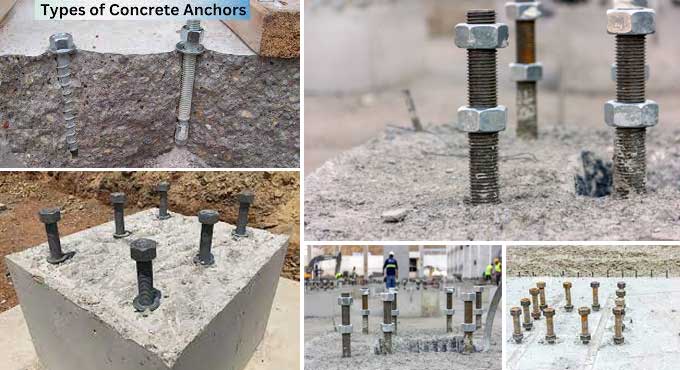
Concrete Anchors: Installations, Function and Varieties
What do you mean by Concrete anchors?
Concrete anchors are powerful anchoring devices utilised in many different situations. You may hang or fasten goods to concrete, brick, or block walls safely with the use of concrete anchors, which offer a stable mounting mechanism.
They are frequently utilised in industrial, commercial, and residential constructions since they are made to support higher weights and offer a stronger, longer-lasting installation than nails or screws alone.
What are the functions of Concrete Anchors?
The major function of concrete anchors is to make sure that any structure can resist the static and dynamic load. An earthquake is an example of a dynamic load, whereas weight is an example of a static load. Concrete anchors give the concrete more strength and distribute the force of a dynamic or static load across a larger area, lowering the likelihood of failure.
Anchors made of concrete are also commonly used to secure walls and foundations. Structures secured with concrete anchors are more stable and durable than those secured with traditional methods. Furthermore, concrete anchors are capable of expanding with changes in temperature. Due to this, they are the best choice for structures that are often exposed to extreme temperatures.
Concrete anchors are sometimes also utilized for seismic retrofits. Structures can be retrofitted to become more seismically resistant through seismic retrofits. In addition to these modifications, concrete anchors are often installed to strengthen the structure. When an earthquake occurs or another seismic event occurs, this can provide additional stability.
Varieties of Concrete anchors
There are numerous kinds of concrete anchors, so consider your project's needs while selecting the finest one. Each kind of anchor has particular advantages and could be most appropriate for particular purposes. Knowing the different sorts and what they can accomplish for you will make it easy to pick the proper anchor for the task.
- Mechanical anchors are the first type of concrete anchor. Most anchors of this type are designed to hold a wide range of forces. Heavy-duty applications can be undertaken with them, and they come in a variety of forms.
- Chemical anchors, commonly referred to as anchoring epoxy, are the second kind of concrete anchor. Drilling a hole into the concrete, injecting the chemical anchor there, and letting it expand and solidify are the steps used to create these anchors. This kind of anchor is well-liked for its power, steadiness, and capacity to withstand shock and vibration. Chemical anchors are frequently used to fasten railings and balconies to concrete surfaces.
- Last but not least, there is a type of anchor known as a concrete insert anchor. Installing insert anchors into existing concrete is the purpose of insert anchors. In addition to fastening beams, machinery, and structural parts to concrete, they are available in various sizes and shapes.
How can you install a concrete anchor?
In order to install a concrete anchor you are going to need a few tools which are:
- Concrete anchor
- Hammer drill
- Open-end wrench
- Mallet
- Brush, or Vacuum
- Setting Tool
The process of installing concrete anchors is as follows:
- Before proceeding, verify the bolt's length and diameter. Often, the width of your drill bit can be determined by an indicator on your concrete anchor.
- The masonry bit must be located, measured, and then numbered based on the anchor's length. Marking your bit before drilling straight through concrete makes the job easier.
- Cleaning the concrete surface is the first step in drilling into it. An anchor hole should be drilled 1.3 to 2.5 cm deeper than its full length.
- You can clean the drill bit with a brush, compressed air, or a vacuum after you've completed drilling. As much rubbish as possible should be removed from the hole to prevent your anchor from becoming unsteady.
- You may now lower the anchor if the hole is debris-free. There is a hole in each sleeve anchor, whether it is a drop-in, lag shield, or sleeve anchor. After dropping the anchor or sleeve into the hole, hammer it with a mallet to ensure it's securely inserted.
- To release the pin, insert the setting tool into the threaded sleeve of the drop-in anchor. A loud, ringing tone should eventually give way to a quieter, steadier tone as you pound. You should not worry about this if you are not using a drop-in anchor.
- The nut, bolt, or screw should be inserted into the concrete anchor and snugly tightened. If you tug on the anchor, you will be able to see how well it holds. If the installation was done properly, there should not be any changes required.
- Once the concrete has been set, anchors can be used to secure a variety of objects.
Inspection and maintenance of concrete anchors
A crucial component of any building structure, concrete anchors support a variety of materials during construction or remodelling work. As a result, it is importantl that they have regular maintenance and inspections to make sure they stay safe and secure. Depending on the kind, size, and application of the concrete anchors, maintenance and inspection may include a number of processes.
It is critical to confirm that the installers utilized the appropriate type of concrete anchor for the task in order to properly maintain and check concrete anchors. The installer should make sure the proper grade and style of the anchor are utilized, for instance, if the anchors are being used for heavy-duty applications like lifting weights.
To get more details, watch the following video tutorial.
Video Source: Albany County Fasteners
The anchors must be regularly inspected after installation to make sure they remain in good condition. Check for rust, corrosion, cracking, or any other signs of deterioration as part of regular maintenance. A secure concrete anchor must be embedded in concrete and should not show signs of movement or loosening.


